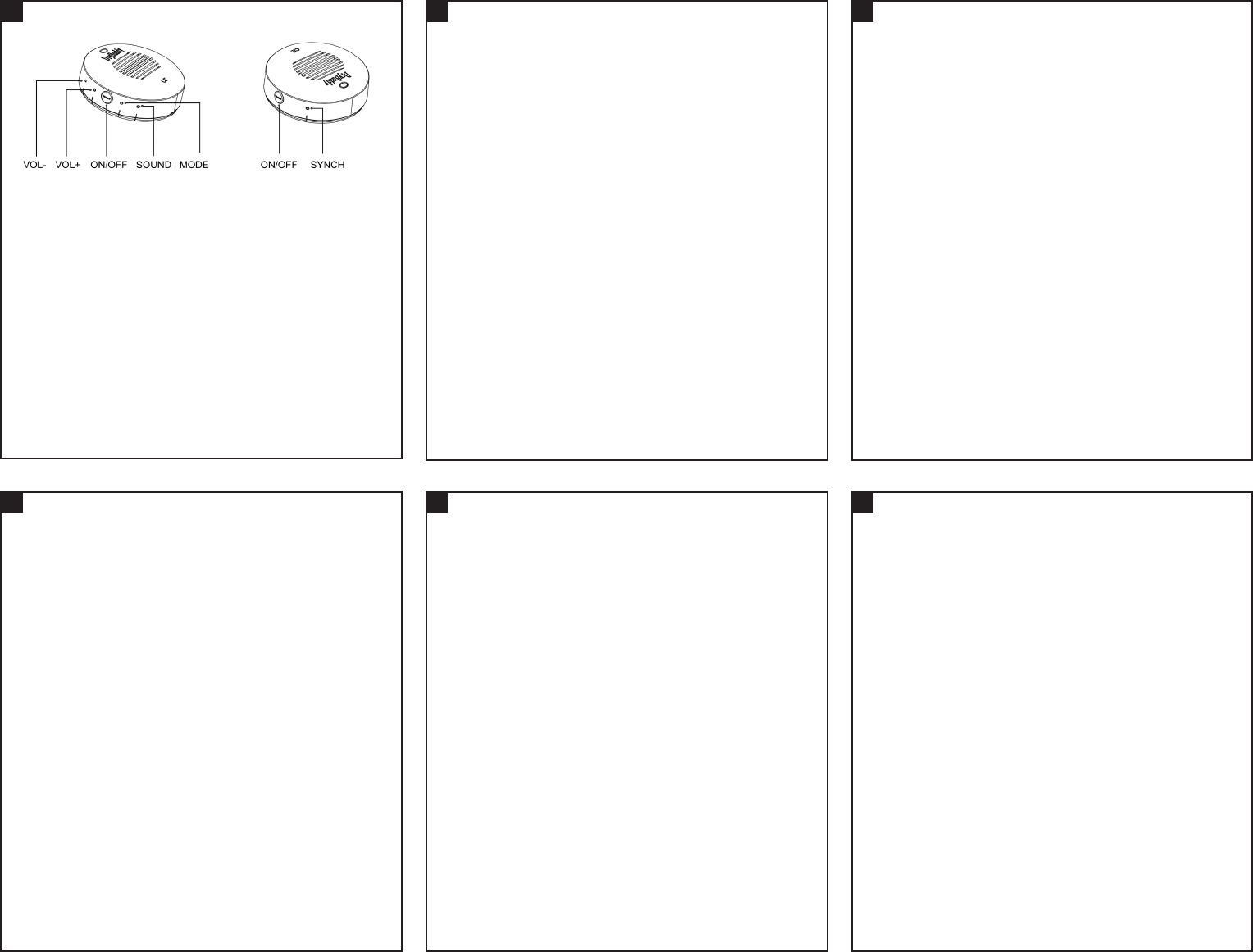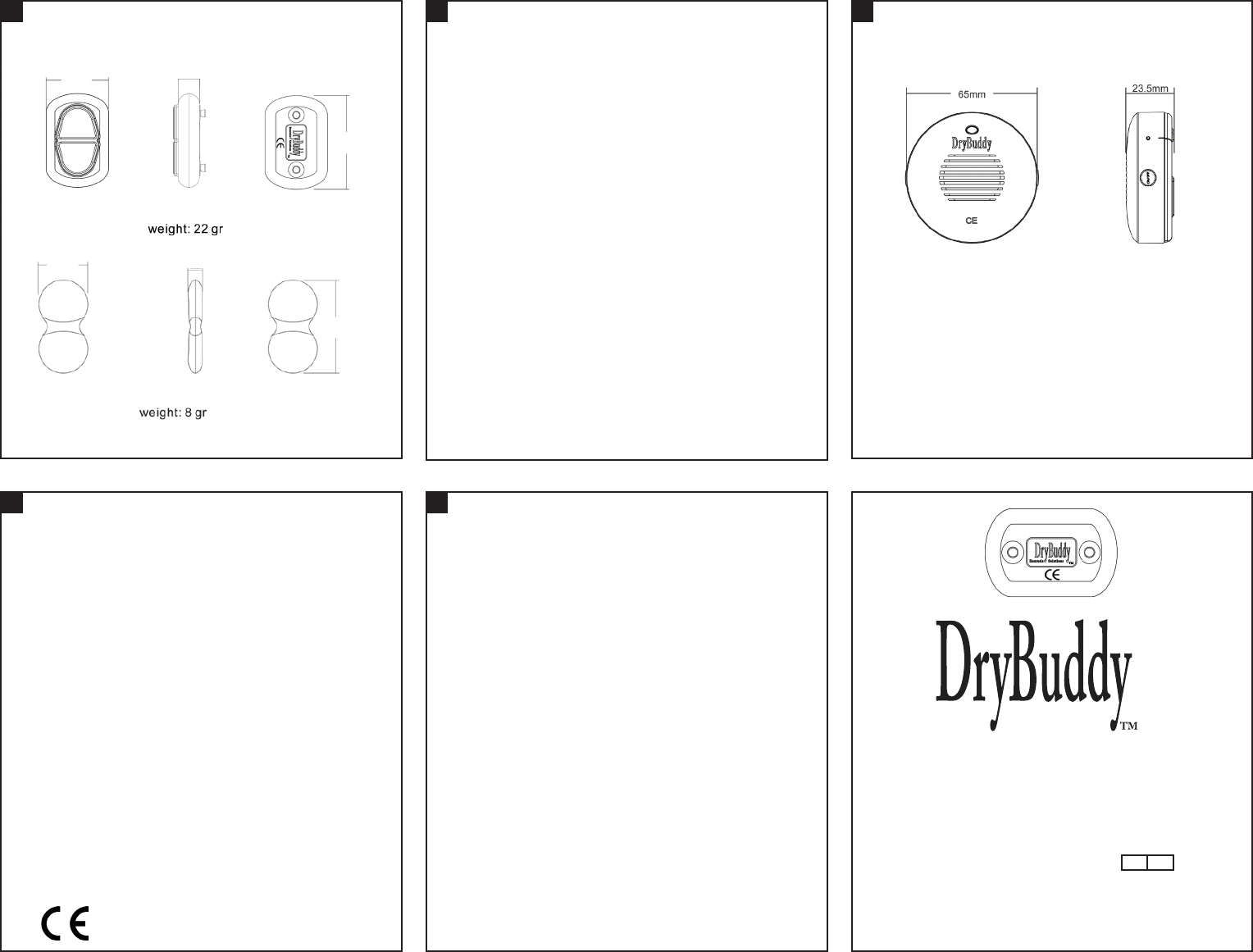Enuresis Solutions DB1 DryBuddy1 Receiver User Manual
Enuresis Solutions, LLC DryBuddy1 Receiver
User Manual

the sensor by placing a clean metal conductor (such as a
key, screwdriver or knife) across the two magnets and
making good electrical contact. This activates the sensor.
The steady Green is followed by blinking Green every 5
seconds. Ten (10) seconds after the Synch is set, the
Receiver will switch itself OFF.
Notes: If the new synchronization is not completed within 15
seconds, the Blue light will stop and the Receiver will revert
to its synchronization before the new synchronization was
attempted, and switch itself OFF. Once the Sensor has been
activated it cannot be activated again for two (2) minutes.
Do not synchronize the DryBuddy1 while the Receiver is
indicating a low battery (Yellow blinking light). Insert fresh
batteries and synchronize. The Sync button will not function
when the power is ON.
You must re-synchronize the Sensor and Receiver if either
the Sensor or the Receiver are changed or synchronization is
lost for any reason.
DryBuddy1 Instructions & Details (Con’t)
3
4 5 6
1 2
The DryBuddy1 oers convenience, privacy and reliability
to patients (or children) who need to be alerted when
enuresis, bed-wetting or unintentional urination occurs.
It is truly wireless, and can be used when the DryBuddy1
Receiver is being carried by the patient or is within
proximity (up to 3 meters or 10 feet) of the wireless Sensor
being used by the patient.
DryBuddy1 Controls
All controls of the DryBuddy1 are on the circular side of the
DryBuddy1 Receiver. Except for the On/O switches, these
switches are below the surface and can be reached and
pressed by using a dull pointed instrument such as a small
screw driver or straightened metal paper clip. This prevents
any accidental or unintentional switching of the DryBuddy1.
Switching the DryBuddy1 ON and OFF
When the two Power ON/OFF buttons are pressed together
for two (2) seconds, the power will be turned ON or OFF.
When the power is turned ON, a Green light will ash twice.
When the power is turned OFF, a Red light will ash twice.
When the Receiver power is OFF, pressing the small control
buttons (switches) on the side turns the Receiver on briey
so that the buttons can function and the Receiver is set to
the next new setting for the button being pressed.
When the Receiver power is ON, pressing the small Mode
button activates the Receiver and indicates the current
setting of the Receiver. (Mode, Sound and Volume). The Vol.
and Sound buttons will not function when the Power is ON.
Synch
The DryBuddy1 Sensor and Receiver must be synchronized
so that they work with the same code. A new DryBuddy1
system has been synchronized at the factory. To re-
synchronize, rst make certain that the Power is OFF. Then:
1. Press the Sync button in the side. A Blue light will ash,
and the Receiver is placed in synchronization mode for
fteen (15) seconds.
2. While the Blue light is ashing, short the two magnets on
Mode
The Mode switch allows the user to change the mode or
type of alert.
When the power is ON: Pressing the Mode button plays the
current settings for the Receiver.
When the power is OFF: Each “press” of the switch will
result in the alert changing in the following order:
1. Sound only
2. Sound + Strong Vibration
3. Strong Vibration only
4. Low Vibration only
Each time that the Mode switch is pressed, the alert only
changes in the direction
1. → 2. → 3. → 4. → 1.
Volume
The Vol + and - buttons increase or decrease the volume level
of the sound. The DryBuddy1 has ve (5) volume levels. The
mode must be set to Music so that the sound can be heard.
When the power is OFF: Pressing the + or - button changes
the sound setting to the higher or lower volume setting and
this new volume is heard briey. If the sound volume is to be
increased or decreased further, press the + or – buttons again.
Note: The volume buttons set the sound volume to what
will be heard if the DryBuddy1 is set to the Sound or
Sound+Vibration modes.
Note: The Volume buttons will not function when the power
is ON.
Sound
The DryBuddy1 oers two audible alarms – a Trumpet
Fanfare and a Berlin Police Siren. The sound can be
changed by pressing the Sound button. The mode must be
set to Music so that the sound can be heard.
When the power is OFF: Pressing the Sound button
changes the sound to the next sound - either the Trumpet
Fanfare or the Berlin Police Siren.
Note: The Sound button will not function when the power
is ON.
Length of Alert
If the alarm’s alert is not turned OFF manually, the alarm can
continue for a Short Alert time or a Long Alert time.
With a Short Alert, the alert will stop after about 2 minutes, and
the Receiver will be switched OFF. This is the default (factory)
setting for the DryBuddy1.
With a Long Alert, the alert will keep repeating its alert cycle
till the Receiver is manually switched OFF or the batteries are
drained.
To set the length of the alert, rst press the Synch button.
While the Blue sync light is ashing for 15 seconds:
1. For a Short Alert, press the Vol. – button. A yellow light
will ash once.
2. For a Long Alert, press the Vol. + button. A yellow light
will ash twice.
The Receiver automatically turns itself OFF after the Yellow
light ashes. The Receiver must now be switched ON again in
order to continue using the DryBuddy1.
When to Sychronize
Every DryBuddy1 Sensor has its own unique code transmitted
to the Receiver. This allows many DryBuddy1 systems to be in
close proximity without interfering with one another. If the Sensor
is changed or synchronization lost for any reason, the Sensor and
Receiver must be synchronized again.
Do not synchronize the DryBuddy1 while the Receiver is
indicating a low battery (Yellow blinking light). Insert fresh
batteries and synchronize.
DryBuddy1 Instructions & Details DryBuddy1 Instructions & Details (Con’t)
Using the DryBuddy1 Using the DryBuddy1 (Con’t)
DryBuddy1 Instructions & Details (Con’t)

Receiver
• Uses two (2) replaceable AAA alkaline batteries.
• Uses a unique coding system so that it can only be used
with a DryBuddy1 Sensor.
• Must be synchronized with a DryBuddy1 Sensor.
• Typical reception distance is up to three (3) meters or ten
(10) feet from the Sensor. The actual transmission distance
depends upon object and materials between the Sensor
and Receiver.
Sensor
• Can be attached to standard cotton briefs using the
patented magnetic attachment system, or
• Can be attached to optional DryBuddy wetness sensing
briefs which contain patented redundant wiring. These
briefs provide a reliable and very large wetness sensing
area.
• Uses a unique coding system so that it can only be used with a
DryBuddy1 Receiver.
• Must be synchronized with a DryBuddy1 Receiver.
• Typical transmission distance is up to three (3) meters
or ten (10) feet to the Receiver. The actual transmission
distance depends upon object and materials between the
Sensor and Receiver.
• Sealed unit with non-replaceable battery.
• Designed and tested to trigger (transmit) over 2,000 times
under typical and proper use.
• When triggered, the sensor will remain inactive for 2
minutes before it can be triggered again.
• Certications: FCC RHU-DBFLS02; CE
ESTBA1508012214R
• RoHS compliant.
Note: Once a Sensor is triggered (or shorted) to transmit an alert
signal, the sensor will remain inactive for two (2) minutes and cannot
be triggered again till this inactive period is over.
Sensor
Weight (without batteries): gr
The DryBuddy1 is designed in USA. Assembled in China.
©2016 by Enuresis Solutions, LLC
Enuresis Solutions, LLC
51 W. Fairmont Avenue, Suite 2
Savannah, GA 31406 USA
912-352-8854
service@drybuddy.com
Advena Ltd.
Tower Business Centre, 2nd Flr.,
Tower Street, Swatar, BKR 4013 Malta
EC REP
• The DryBuddy alarm is intended for use as a bed-wetting
and enuresis alarm by children of age ve and older, or as
recommended by a medical authority. It can be used by older
patients as a urine sensor and wetness alarm and as an
incontinence alarm.
• The DryBuddy system is a medical device and should be
treated as such. Do not use roughly or damage.
• Do not use as a potty training aid for babies, toddlers and
young children.
• Make certain that no parts of the DryBuddy or sensor are put
in the mouth for any reason as this could cause choking or
other harm.
• Observe all sanitary precautions to keep the sensor clean and
the alarm parts clean and dry.
• Do not use the sensor for more than one user without
thorough cleaning.
• Do not strike the magnetic sensor or cap on hard surfaces or
make them hot as this can reduce magnetism.
• The DryBuddy system is designed to sense urine or salty
water. It is less eective in sensing plain water.
1
DryBuddy1 Specications (Con’t)
9
Good Things Happen with DryBuddy�
Raising the Standards for Mobility,
Privacy, Performance and Value.
FCC Warning:
10 11
7 8
DryBuddy1 Specications DryBuddy1 Specications (Con’t)
Caution when Using the
DryBuddy1 Specications (Con’t)
• Contains an audio alarm which can be as loud as 93 dB
at 20 cms. (8 “), 89 at 40 cms. (16”), 86 dB at 60 cms. (24”).
Please adjust to a suitable loudness level using the Volume
control in the Receiver.
• Certications: FCC XXXXXXXXXX; CE
ZZZZZZZZZZZZZZZ
• RoHS compliant.
32 mm
48 mm
42 mm
17 mm 6 mm
13.5 mm
This equipment has been tested and found to comply with the limits for a Class B
digital device, pursuant to part 15 of the FCC Rules. These limits are designed to
provide reasonable protection against harmful interference in a residential installation.
This equipment generates, uses and can radiate radio frequency energy and, if not
installed and used in accordance with the instructions, may cause harmful interference
to radio communications. However, there is no guarantee that interference will not
occur in a particular installation. If this equipment does cause harmful interference to
radio or television reception, which can be determined by turning the equipment off
and on, the user is encouraged to try to correct the interference by one or more of the
following measures:
• Reorient or relocate the receiving antenna.
• Increase the separation between the equipment and receiver.
• Connect the equipment into an outlet on a circuit different from that to which the
receiver is connected.
• Consult the dealer or an experienced radio/TV technician for help.
Caution: Any changes or modifications to this device not explicitly approved by
manufacturer could void your authority to operate this equipment.
The device has been evaluated to meet general RF exposure requirement. The device
can be used in portable exposure condition without restriction.
The device has been evaluated to meet general RF exposure requirement. The device
can be used in portable exposure condition without restriction.
This device complies with part 15 of the FCC Rules. Operation is subject to the
following two conditions: (1) This device may not cause harmful interference, and (2)
this device must accept any interference received, including interference that may
cause undesired operation.
DryBuddy1